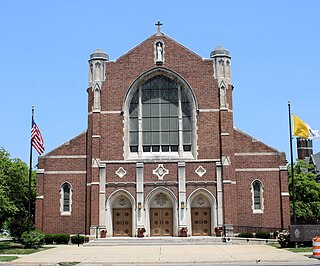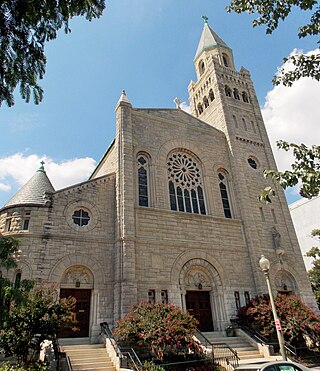
Cathedral of Saint Augustine is a Catholic cathedral and parish church located in Kalamazoo, Michigan, United States. It is the seat of the Bishop of the Diocese of Kalamazoo. The parish was founded in 1856, the present church building was completed in 1951, and it was raised to cathedral status in 1970.

The Church of the Holy Rosary of the Blessed Virgin Mary was a Catholic parish church of the Archdiocese of New York located at 444 East 119th Street, in the East Harlem neighborhood of Manhattan in New York City.

St. Brigid's Roman Catholic Church, also known as St. Brigid's or Famine Church, is a church located at 123 Avenue B, on the southeast corner of East 8th Street, along the eastern edge of Tompkins Square Park in the Alphabet City section of the East Village of Manhattan, New York City. Associated with the church is a parish school, Saint Brigid School, consisting of grades Pre-K through 8, which has been in existence since 1856.

St. Mary of Częstochowa in Cicero is an historic church of the Archdiocese of Chicago located in Cicero, Illinois.

St. Peter the Apostle Church was a Roman Catholic church located within the Archdiocese of Baltimore in Baltimore, Maryland. Constructed at the northwest corner of Hollins and South Poppleton Streets and, it was often referred to as "The Mother Church of West Baltimore."

St. Mary's Catholic Church, also known as St. Mary of the Visitation Church, is a parish church of the Diocese of Davenport which is located in Iowa City, Iowa, United States. The church building and rectory were listed together on the National Register of Historic Places in 1980. They were both included as contributing properties in the Jefferson Street Historic District in 2004. The parish's first rectory, which is now a private home, is also listed on the National Register as St. Mary's Rectory. It is located a few blocks to the east of the present church location at 610 E. Jefferson St.

St. Lucy's Church is a former parish church of the Parish of St. Lucy, which operated under the authority of the Archdiocese of New York in the East Harlem section of the Borough of Manhattan in New York City. The parish address was 344 East 104th Street; the parochial school occupied 336 East 104th Street. The parish merged with St. Ann's Church in 2015, and Masses and other sacraments are no longer offered regularly at this church.

The Church of the Sacred Heart is a Roman Catholic parish church in the Roman Catholic Archdiocese of New York, located at 1253 Shakespeare Avenue, Bronx, New York City 10452. The church building was designed by architect Elliott Lynch, who designed several other Catholic churches and parish schools. The church is connected with a school of the same name.
The Church of St. John the Baptist is a Catholic parish church in the Archdiocese of New York, at 211 West 30th Street between Seventh and Eighth Avenues in the Fur District of the Chelsea neighborhood of Manhattan in New York City. To the church's rear is the Capuchin Monastery of St. John the Baptist, located at 210 West 31st Street across from New York Penn Station and Madison Square Garden.

The Church of St. Veronica was a Roman Catholic parish church in the Roman Catholic Archdiocese of New York, located at 153 Christopher Street between Greenwich and Washington Streets in the West Village area of the Greenwich Village neighborhood of Manhattan, New York City. The parish was established in 1887, and the church was built between 1890 and 1903. It is located within the New York City Landmarks Preservation Commission's Greenwich Village Historic District Extension I, which was designated in 2006.

The Church of St. Rose of Lima is a Roman Catholic parish church in the Roman Catholic Archdiocese of New York, located at 510 West 165th Street between Audubon and Amsterdam Avenues in the Washington Heights neighborhood of Manhattan, New York City. The Romanesque Revival church was designed by Joseph H. McGuire and built in 1902–05.

The Church of Our Lady of the Scapular–St. Stephen is a Roman Catholic parish church in the Roman Catholic Archdiocese of New York, located at 149 East 28th Street between Third and Lexington Avenues in the Rose Hill neighborhood of Manhattan, New York City. It was established in the 1980s when the parish of the Church of Our Lady of the Scapular of Mount Carmel was merged into the parish of the Church of St. Stephen the Martyr. In January 2007, it was announced by the Archdiocese of New York that the Church of the Sacred Hearts of Mary and Jesus, located at 307 East 33rd Street, was to be merged into Our Lady of the Scapular–St. Stephen, then, in November 2014, the Archdiocese announced that the Church of Our Lady of the Scapular–St. Stephen was one of 31 neighborhood parishes which would be merged into other parishes. Our Lady of the Scapular–St. Stephen was to be merged into the Church of Our Saviour at 59 Park Avenue.

The Church of St. Barnabas is a Roman Catholic parish church under the authority of the Roman Catholic Archdiocese of New York, located at Martha Avenue near East 241st Street in Woodlawn Heights, The Bronx, New York City. The parish was established in July 1910 by the Rev. Michael A. Reilly, separated from the Bronx parish of St. Frances of Rome. It is one of the largest parishes in the Archdiocese.
The Church of St. Martin de Porres is a Roman Catholic parish church under the authority of the Roman Catholic Archdiocese of New York, located in Poughkeepsie, Dutchess County, New York.

The Old Church of St. Peter is a Roman Catholic church established under the authority of the Roman Catholic Archdiocese of New York in Poughkeepsie, Dutchess County, New York in 1837. It is the second oldest Catholic Church on the Hudson and is considered the Mother Church of the Hudson Valley because from it all the parishes in Ulster and Dutchess counties were founded. The church is also referred to as Our Lady of Mount Carmel since 1965 when St. Peter's parish relocated to Hyde Park, New York and the parish of Our Lady of Mount Carmel church relocated to site.
The Old Church of St. Rose of Lima is a former Roman Catholic parish church which was under the authority of the Roman Catholic Archdiocese of New York, located at 36 Cannon Street between Broome Street and Delancey Street in the Lower East Side of Manhattan, New York City. The rectory was located at 42 Cannon Street; the school was located at 290 Delancey Street. The 1871 church was described by The New York Times when it opened in 1871, as one of the finest churches in the city. The church was demolished around July 1901 and the site redeveloped in conjunction with the erection of the Williamsburg Bridge (1903) and public housing. A new church was begun shortly after property was purchased in July 1900 at Grand and Lewis Streets. The parish closed in the 1960s.

The Church of the Incarnation is an American Roman Catholic parish church in the Roman Catholic Archdiocese of New York, located at 1290 St. Nicholas Avenue at the corner of 175th Street and St. Nicholas Avenue, Washington Heights, Manhattan, New York City, New York. The church is known as "the St. Patrick's Cathedral of Washington Heights".

St. Mary Church is a Roman Catholic church, part of Annunciation Parish, located in Newington, Connecticut. St. Mary School closed in 2016. A new pastor, Fr Shawn Daly was appointed in 2016 to oversee the restructuring of the new Annunciation Parish, combining St. Mary Church with Holy Spirit Church in Newington.

The Church of St. Joseph is the Catholic parish church for St. Joseph Parish, a national parish in New York City founded in 1873 to serve the German-speaking residents of the Yorkville neighborhood on the Upper East Side of Manhattan.

St. Peter's Church, also referred to as St. Peter's on Capitol Hill, is a Roman Catholic church located on Capitol Hill in Washington, D.C., within the Archdiocese of Washington. Founded in 1820, St. Peter's is the second oldest Catholic parish in the City of Washington. The church building was originally constructed in 1889. However, it was destroyed by a fire in 1940 and rebuilt. The church's motto is, "To be a tangible manifestation of Christ in the community."





















